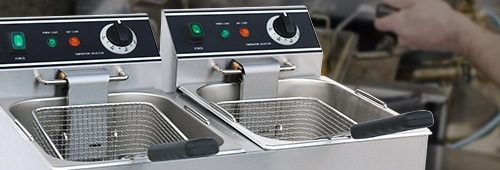Commercial Deep Fryer Buying Guide
Post on 22/11/2022
From fried chicken, fries and doughnuts to tempura and spring rolls, people around the world use “deep frying” to create impressive dishes, which is why most restaurants have a commercial deep fryer. If you’re considering buying or upgrading a deep fryer, follow this article from Chefmax to learn all about it, as we share all kinds of knowledge about deep fryer, including principles, types, buying guides and tips.
1. What is deep frying and deep fryers?
Deep frying is a fast cooking method that involves cooking food in large amounts of hot oil. Typical frying temperatures are between 340°F (171°C) and 350°F (177°C). Although both liquid and solid oils are liquid at certain temperatures, frying is classified as dry cooking because it takes away the moisture and gives the food a crispy crust.
A commercial deep fryer refers to equipment that can heat large amounts of cooking oil in a short period of time and is used to cook foods that need to be deep fried in all types of snack bars, bars, cafes, dessert stores, and restaurants. It is so widely used that vegetables, meat, and dough can be fried.
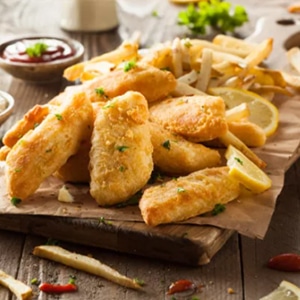
2. What are the types of commercial deep fryer?
The most important factor that distinguishes the fryer is the style of the heating tube, which directly determines the use of the machine.
A. Open-pot Fryers
The feature of the burner tube placed outside the cylinder distinguishes this deep fryer from other types, which require heating the metal cylinder before heating the cooking oil.
Features:
• Suitable for cooking French fries, onion rings, potato pancakes and other products with low deposits
• Large frying area
• Small “V” shaped cooling zone
• Burning tube does not block the cleaning of the inside of the oil cylinder
• Less prone to breakdowns and easier to maintain
Disadvantages:
• Not suitable for cooking products with a lot of deposits, debris may be carbonized
• Less energy efficient than tube type, slower preheating
B. Tube-type Fryers
Tube-type fryers are heated using gas transported by pipes laid inside the cylinder, either LPG or NG as the energy source.
Features:
• Considerable cold oil area under the burner tube to collect deposits, preventing carbonization and helping to extend the life of the oil
• Ideal for cooking products with high deposits, such as vegetables and meat covered in breadcrumbs
• Burner tube immersed in oil for faster preheating
• Ideal for heavy and frequent frying
Disadvantages:
• Much of the oil stays in the cold oil area and does not fry well
• Burner tube blocks crumb cleaning

C. Ribbon Fryers
This commercial deep fryer is electrically powered and has a band of heating tubes running through the bottom of the cylinder, combining the advantages of the two types above and making it very versatile.
Features:
• Wide applicability to cook a wide range of products
• Has a cold oil zone
• Some models can be lifted and cleaned
• Highest efficiency for fast preheating and temperature recovery
• More accurate temperature measurement than gas fryers
Disadvantages:
• Requires more frequent cleaning, debris can come in contact with the heater tube and burn
• Difficult to clean under and behind the heater tube

D. Flat Bottom Fryers
This type of fryer is similar to open-pot fryers, with almost no cold oil area. It has a very shallow oil tank, which is only suitable for cooking foods with low density that can float on top of the oil.
Features:
• Suitable for cooking doughnuts, fried fish, tortilla chips and other floating items
• The heating element does not prevent cleaning the bottom of the tank
• Wide cooking area
Disadvantages:
• No cold oil area, crumbs easily scorched
• Smaller cooking area
• Requires longer preheating time
E. Pressure Fryers
This is a specialty fryer that is sealed and pressurized for faster and deeper cooking and is often used to fry large pieces of meat or whole chickens.
Features:
• Suitable for cooking high and low deposition foods
• Suitable for high volume and high volume cooking
• Dramatically reduces cooking time
• Allows cooking at lower temperatures, extending the life of the oil
• Retains internal moisture in meat, making it tender and juicy
Disadvantages:
• Higher cost
• Sealed feature does not allow opening during cooking

3. How to choose the right commercial deep fryer?
You need to consider many aspects in conjunction with the current situation to find the fryer that truly meets expectations.
A. Energy
Commercial deep fryer use either gas or electricity as the energy source. Choosing between these two sources of energy is not only a matter of price, but also of understanding the advantages and disadvantages of each.
• Gas: Higher cooking temperatures can be achieved, which means they cook faster and generally have a larger capacity to cook more, but the initial setup and connection of a gas unit is more expensive than electricity.
• Electric: For electric fryers, they are more mobile because electric outlets are easier to find and set up than gas lines, and because less heat is lost due to the heating tubes being directly submerged in the oil, and the short preheat time allows for faster heat recovery between batches. However, they have a lower maximum cooking temperature than gas, so they require longer cooking times.
B. Space and size
Kitchens with limited kitchen space can benefit from a countertop fryer. Generally, gas fryers are larger than electric fryers because they leave room for the combustion system.
• For small restaurants, food trucks and restaurants with few fried items on the menu, countertop fryers are the best choice, and they are available in models that do not require ventilation.And they are available in models that do not require venting to improve convenience, with 8-14L capacity to meet demand.
• If you need to make large quantities of frequently fried products, floor fryers are perfect for your needs, and they may be available in capacities of 25L-30L or more. However, please note that floor fryers take up a lot of space and should always be used with a ventilated hood.
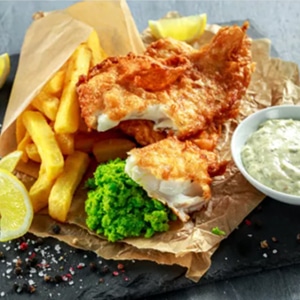
• In terms of single and multiple tank options, if you mainly serve French fries and tortilla chips, a single tank fryer will meet the needs, but if you need to make multiple foods such as fried chicken, fried dough, fried vegetables, etc., then a double tank brings more help, you can cook the products at different temperatures and their flavors will not affect each other.
C. Oil filtration measures
Filtration measures are directly related to the performance, taste and consumption of the oil. It is not economical to change the oil after each batch. Proper filtration allows the oil to be reused many times without degrading the flavor and saving business costs.
Oil filtration is a daily task and may be required more than once per day if the oil is used for a long period of time and the frying volume is high. Many floor fryers come with an oil filter cart and automatic pump that cleans the oil of impurities by simply replacing the filter paper and screen, and although models with a filter cart are more expensive, they can better maintain oil quality and save on labor. Countertop fryers do not have the space for an oil filter cart, so they require manual oil filtering using oil filter paper.
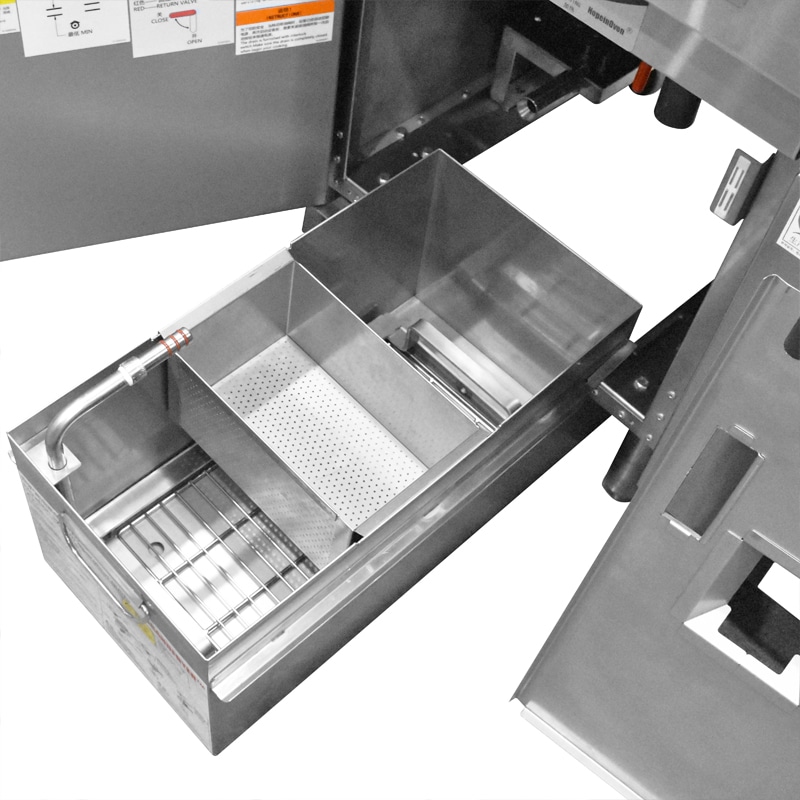
D. Thermal recovery time
Recovery time is the time it takes for the fryer to return to cooking temperature after cold food is put into the fryer or cooked food is removed.
• When putting cold food into the commercial deep fryer, the oil temperature will drop quickly and the food will easily stick at this time. If the fryer supplies more heat at this moment and quickly returns to cooking temperature, the probability of food sticking will be reduced and the taste will be better.
• The heat recovery time between batches determines the length of the service cycle and the efficiency of the kitchen. Temperature is critical for fryers. If the recovery time is too slow and food is added when the oil is not hot enough, the grease will invade the inside of the food, causing a loss of taste and oil waste.
So if you need a large and uninterrupted supply of fried food, choose the type where the heating element is immersed directly into the oil, which will result in faster heat recovery between batches. If the time between batches is not critical, choose a high temperature gas fryer for your fried food.
E. Computer Control
There are two benefits to choosing a commercial deep fryer that has a computer programmed control.
One is that they all have temperature profile sensing, so you can increase the power output to quickly restore the temperature when the oil temperature drops. Second, you can use the computer for menu editing and memory, set different cooking cycles for different frying products, time and temperature can be set to control the cooking details during busy shifts, so that the cooking quality will not be affected by forgetting, and so that the staff can feel free to do other work, improving kitchen efficiency and ensuring the quality and safety of cooking.
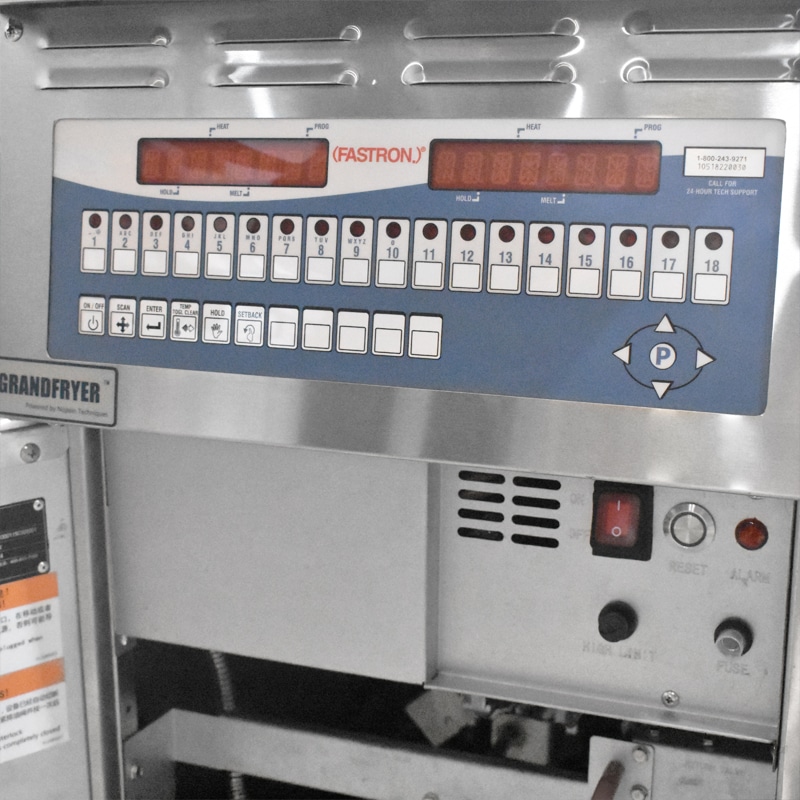
F. Automation and safety
The automatic lifting system brings convenience and safety to the kitchen. You can preset the time to lower and raise the baskets, so you don’t have to keep an eye on the clock when processing orders during peak hours, and you don’t have to worry about over-frying food.
4. Use of skills
The use of commercial deep fryer is not complicated, but the special nature of frying requires people to follow the principles to achieve better cooking results.
A. Use of oil
• Butter, margarine, olive oil or animal oil are not recommended. Their smoke point is low, and they will smoke and pollute under high temperature. You need to use high-quality vegetable oil or peanut oil. After each use, filter it and replace it regularly.
• If the temperature is raised from 163 ℃ to 177 ℃, the oxidation rate of oil will be more than doubled, and they will soon deteriorate. Therefore, it is very important to cook within the normal temperature range.
• The best tasting oils are those that have been used for 2-3 days, the same batch of oil should not be used for more than 5-6 days, and frequently used oils need to be replaced more quickly.
B. Operating Tips
• Do not exceed the maximum water level when adding cooking oil, which will consume more energy, make it difficult for the food to heat evenly and ripen, and also make the equipment overload, increasing the probability of failure.
• Putting too much food in at one time will not speed up your efficiency, instead overcrowding will slow down the time it takes for the food to ripen, so look through the Read the instructions to find the optimal amount of each type of food.
• For better consistency in the finished product, do not fry frozen or room temperature foods together in the same pan.
• Stir the oil before starting the first time each day to ensure even temperatures.
• Remove debris regularly and deeply strain the oil at the end of each day’s operation.
• Excessive water or ice particles can cause hot oil to splash or blister. Frozen, undercooked chicken should be thawed to remove excess water and patted dry with paper towels before cooking.
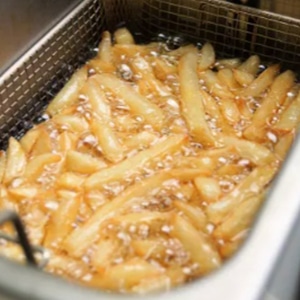
5. Summary
Deep frying has a long history and is now used in all kinds of restaurants to prepare entrees, side dishes, snacks and desserts, and is also popular in street fryer stalls, a proper commercial deep fryer can obviously help your business a lot. If you need more professional information about fryers, please contact Chefmax.
